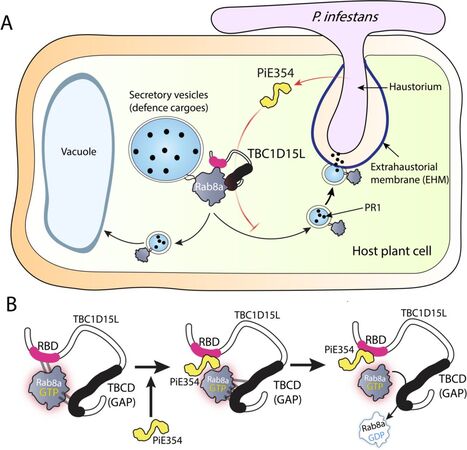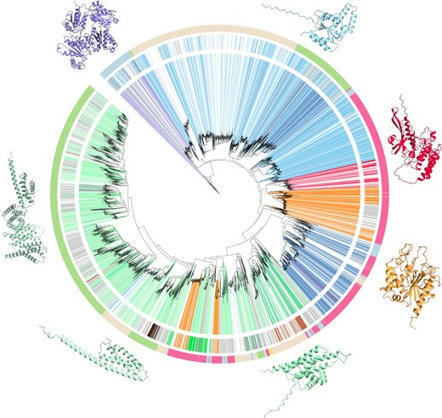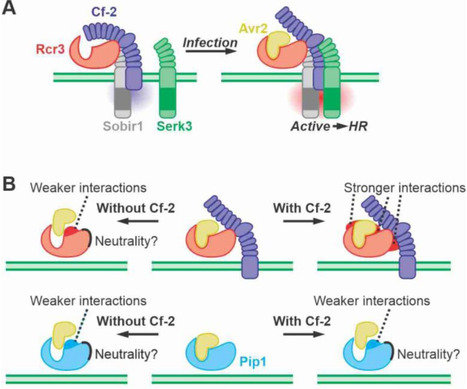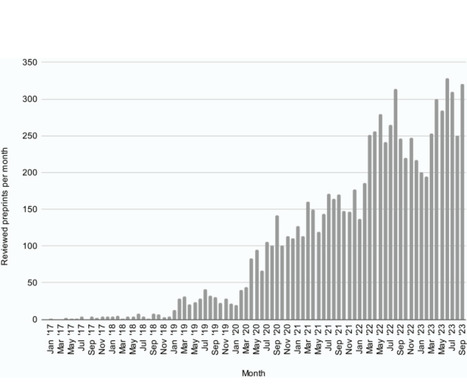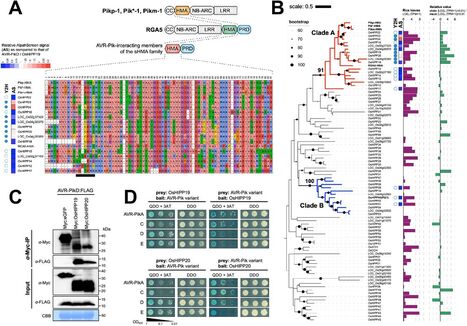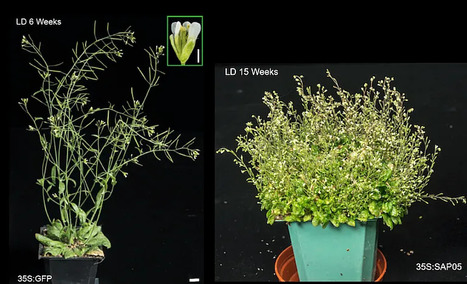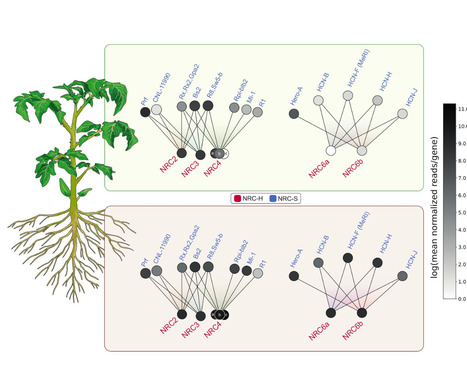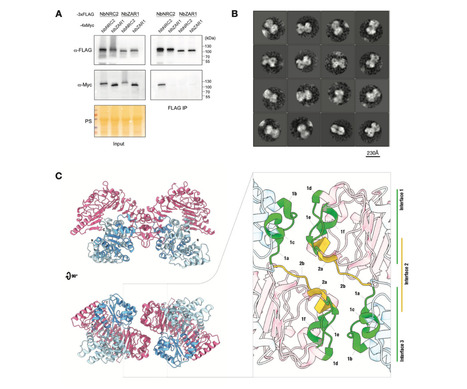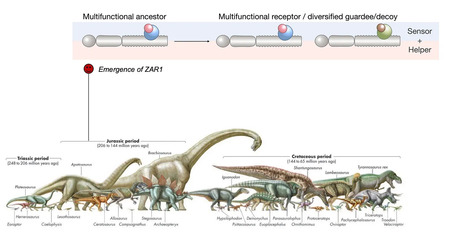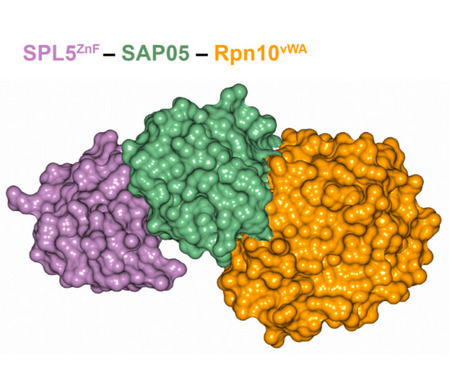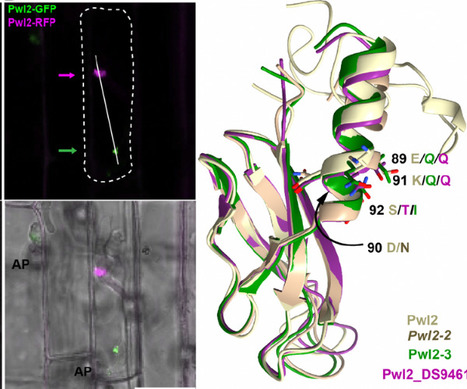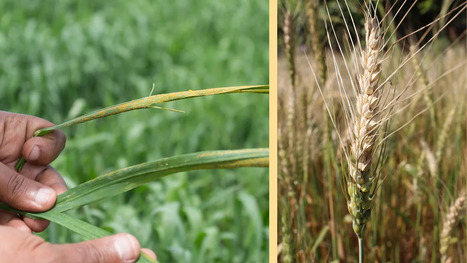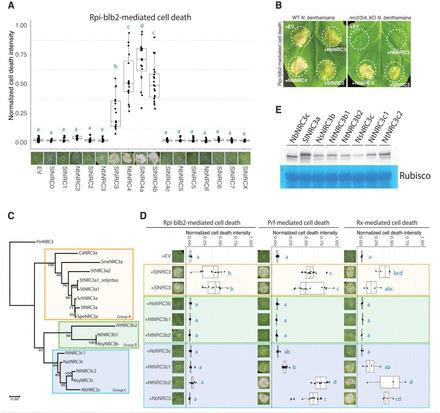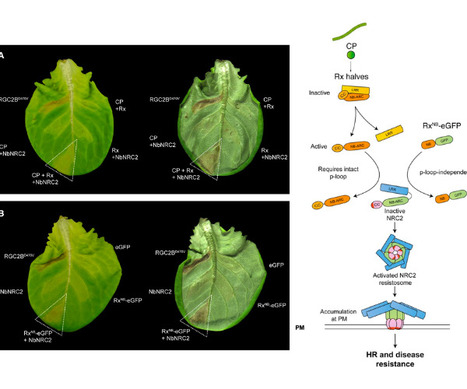 Your new post is loading...
 Your new post is loading...
Pathogens have evolved sophisticated mechanisms to manipulate host cell membrane dynamics, a crucial adaptation to survive in hostile environments shaped by innate immune responses. Plant- derived membrane interfaces, engulfing invasive hyphal projections of fungal and oomycete pathogens, are prominent junctures dictating infection outcomes. Understanding how pathogens transform these host-pathogen interfaces to their advantage remains a key biological question. Here, we identified a conserved effector, secreted by plant pathogenic oomycetes, that co-opts a host Rab GTPase-activating protein (RabGAP), TBC1D15L, to remodel the host-pathogen interface. The effector, PiE354, hijacks TBC1D15L as a susceptibility factor to usurp its GAP activity on Rab8a—a key Rab GTPase crucial for defense-related secretion. By hijacking TBC1D15L, PiE354 purges Rab8a from the plasma membrane, diverting Rab8a-mediated immune trafficking away from the pathogen interface. This mechanism signifies an uncanny evolutionary adaptation of a pathogen effector in co- opting a host regulatory component to subvert defense-related secretion, thereby providing unprecedented mechanistic insights into the reprogramming of host membrane dynamics by pathogens.
Via The Sainsbury Lab
Nucleotide-binding domain and leucine-rich repeat (NLR) proteins are a prominent class of intracellular immune receptors in plants. However, our understanding of plant NLR structure and function is limited to the evolutionarily young flowering plant clade. Here, we describe an extended spectrum of NLR diversity across divergent plant lineages and demonstrate the structural and functional similarities of N-terminal domains that trigger immune responses. We show that the broadly distributed coiled-coil (CC) and toll/interleukin-1 receptor (TIR) domain families of non-flowering plants retain immune-related functions through trans-lineage activation of cell death in the angiosperm Nicotiana benthamiana. We further examined a CC subfamily specific to non-flowering lineages and uncovered an essential N-terminal MAEPL motif that is functionally comparable to motifs in resistosome-forming CC-NLRs. Consistent with a conserved role in immunity, the ectopic activation of CCMAEPL in the non-flowering liverwort Marchantia polymorpha led to profound growth inhibition, defense gene activation, and signatures of cell death. Moreover, comparative transcriptomic analyses of CCMAEPL activity delineated a common CC-mediated immune program shared across evolutionarily divergent non-flowering and flowering plants. Collectively, our findings highlight the ancestral nature of NLR-mediated immunity during plant evolution that dates its origin to at least ∼500 million years ago.
Via The Sainsbury Lab
Secreted immune proteases Rcr3 and Pip1 of tomato are both inhibited by Avr2 from the fungal plant pathogen Cladosporium fulvum but only Rcr3 act as a decoy co-receptor that detects Avr2 in the presence of the Cf-2 immune receptor. Here, we identified crucial Rcr3 residues for Cf-2-mediated signalling and bioengineered various proteases to trigger Avr2/Cf-2 dependent immunity. Despite substantial divergences in Rcr3 orthologs from eggplant and tobacco, only minimal alterations were sufficient to trigger Avr2/Cf-2-triggered immune signalling. Tomato Pip1, by contrast, was bioengineered with 16 Rcr3-specific residues to initiate Avr2/Cf-2-triggered immune signalling. These residues cluster on one side next to the substrate binding groove, indicating a potential Cf-2 interaction site. Our findings also revealed that Rcr3 and Pip1 have distinct substrate preferences determined by two variant residues and that both proteases are suboptimal for binding Avr2. This study advances our understanding of the evolution of Avr2 perception and opens avenues to bioengineer proteases to broaden pathogen recognition in other crops.
Via The Sainsbury Lab
As preprints become more widely used and accepted, they raise the possibility of rethinking the peer-review process. This Consensus View issues a call to action to accelerate the growing momentum of preprint sharing and provides recommendations to empower researchers to provide open and constructive peer review for preprints.
Via The Sainsbury Lab
Intracellular nucleotide-binding domain and leucine-rich repeat-containing (NLR) receptors play crucial roles in immunity across multiple domains of life. In plants, a subset of NLRs contain noncanonical integrated domains that are thought to have evolved from host targets of pathogen effectors to serve as pathogen baits. However, the functions of host proteins with similarity to NLR integrated domains and the extent to which they are targeted by pathogen effectors remain largely unknown. Here, we show that the blast fungus effector AVR-Pik binds a subset of related rice proteins containing a heavy metal-associated (HMA) domain, one of the domains that has repeatedly integrated into plant NLR immune receptors. We find that AVR-Pik binding stabilizes the rice small HMA (sHMA) proteins OsHIPP19 and OsHIPP20. Knockout of OsHIPP20 causes enhanced disease resistance towards the blast pathogen, indicating that OsHIPP20 is a susceptibility gene (S-gene). We propose that AVR-Pik has evolved to bind HMA domain proteins and co-opt their function to suppress immunity. Yet this binding carries a trade-off, it triggers immunity in plants carrying NLR receptors with integrated HMA domains.
Researchers have uncovered the intricate molecular mechanism used by parasitic phytoplasma bacteria, known for inducing ‘zombie-like’ effects in plants. This detailed revelation opens new horizons for groundbreaking applications in biotechnology and even in biomedicine. Read full article
This month marks the 10th anniversary of bioRxiv, a significant milestone for the biology preprint server that has revolutionized the way biologists share their research. Here is a personal take on 10 things you should know about preprints. 1. Preprints enable you to share your science at an earlier stage 2. Preprints are citable and should be cited 3. Preprinting is not a movement against peer review 4. Anyone can review preprints 5. Preprints can be be copied and redistributed 6. Preprints are free to publish and free to read 7. Funders should mandate preprints 8. Preprints should not be published when the paper is accepted 9. Preprints should include the supporting data 10. You can preprint anything you want
Open science and transparency serve as antidotes to the epidemic of flawed and fraudulent research. And the journey toward open science begins with preprinting. This post is a celebration of bioRxiv’s 10th anniversary.
Nucleotide-binding domain and leucine-rich repeat immune receptors (NLRs) confer disease resistance to a multitude of foliar and root parasites of plants. However, the extent to which NLR immunity is expressed differentially between plant organs is poorly known. Here, we show that a large cluster of tomato genes, which encodes the cyst and root-knot nematode disease resistance proteins Hero and MeR1 as well as the NLR-helper NRC6, exhibits nearly exclusive expression in the roots. This root-specific gene cluster emerged in Solanum species about 21 million years ago through gene duplication from the ancient NRC network of asterid plants. NLR-sensors in this gene cluster exclusively signal through NRC6 helpers to trigger the hypersensitive cell death immune response. These findings indicate that the NRC6 gene cluster has sub-functionalized from the larger NRC network to specialize for resistance against root pathogens, including cyst and root-knot nematodes. We propose that NLR gene clusters and networks have evolved organ-specific gene expression as an adaptation to particular parasites and to reduce the risk of autoimmunity.
Via The Sainsbury Lab
Nucleotide-binding domain and leucine-rich repeat (NLR) proteins can engage in complex interactions to detect pathogens and execute a robust immune response via downstream helper NLRs. However, the biochemical mechanisms of helper NLR activation by upstream sensor NLRs remain poorly understood. Here, we show that the coiled-coil helper NLR NRC2 accumulates in vivo as a homodimer that converts into a higher order oligomer upon activation by 30 its upstream virus disease resistance protein Rx. The Cryo-EM structure of NRC2 in its resting state revealed intermolecular interactions that mediate homodimer formation. These dimerization interfaces have diverged between paralogous NRC proteins to insulate critical network nodes and enable redundant immune pathways. Our results expand the molecular mechanisms of NLR activation pointing to transition from homodimers to higher-order oligomeric resistosomes.
Via The Sainsbury Lab
In the world of science and discovery, luck of course can play a role but it often takes a back seat to dedication, perseverance, and rigorous research. How big is the role of luck in career success? This question has lingered in my mind for decades. I’ve repeatedly been told that I’m lucky — lucky to reside in a Western country, to have secured a job, grants, had a paper accepted, to have exceptional people in my team, to be a good writer and communicator etc. The list goes on, prompting me to reflect — if I tally all these blessings, it seems I must have been touched by a higher power on the day of my birth. The Economist asked the exact same question in a recent column. The article makes a case that career success is significantly influenced by luck, quoting American business magnate and investor Warren Buffett as “winning the ovarian lottery by being born in America”, and “being wired in a way that pays off in a market economy.” Fortunately, the columnists came to their senses and concluded the piece with a more reasonable take:
“If luck can mean a bad decision has a good result, or vice versa, managers should learn to assess the success of an initiative on the basis of process as well as outcome. And if the difference between skill and luck becomes discernible over time, then reward people on consistency of performance, not one-off highs. Mr Buffett might have had a slice of luck at the outset, but a lifetime of investing success suggests he has maximised it.”
Imagine a plant immune system that has been protecting plants since the time of dinosaurs. Sounds fascinating, right? Well, that’s exactly what we discovered about a plant immune receptor called ZAR1. In our recent study, we delved into the evolutionary history of ZAR1 and uncovered some intriguing findings. ZAR1 is a special type of immune receptor known as an NLR, which helps plants defend against pathogens. What’s remarkable is that while most NLRs evolve rapidly, even within the same species, ZAR1 has been remarkably conserved for millions of years. It traces its origins back to the Jurassic period, around 220 to 150 million years ago, when flowering plants were just starting to emerge.
In eukaryotes, targeted protein degradation (TPD) typically depends on a series of interactions among ubiquitin ligases that transfer ubiquitin molecules to substrates leading to degradation by the 26S proteasome. We previously identified that the bacterial effector protein SAP05 mediates ubiquitin-independent TPD. SAP05 forms a ternary complex via interactions with the von Willebrand Factor Type A (vWA) domain of the proteasomal ubiquitin receptor Rpn10 and the zinc-finger (ZnF) domains of the SQUAMOSA-PROMOTER BINDING PROTEIN-LIKE (SPL) and GATA BINDING FACTOR (GATA) transcription factors (TFs). This leads to direct TPD of the TFs by the 26S proteasome. Here, we report the crystal structures of the SAP05–Rpn10vWA complex at 2.17 Å resolution and of the SAP05–SPL5ZnF complex at 2.20 Å resolution. Structural analyses revealed that SAP05 displays a remarkable bimodular architecture with two distinct nonoverlapping surfaces, a “loop surface” with three protruding loops that form electrostatic interactions with ZnF, and a “sheet surface” featuring two β-sheets, loops, and α-helices that establish polar interactions with vWA. SAP05 binding to ZnF TFs involves single amino acids responsible for multiple contacts, while SAP05 binding to vWA is more stable due to the necessity of multiple mutations to break the interaction. In addition, positioning of the SAP05 complex on the 26S proteasome points to a mechanism of protein degradation. Collectively, our findings demonstrate how a small bacterial bimodular protein can bypass the canonical ubiquitin–proteasome proteolysis pathway, enabling ubiquitin-independent TPD in eukaryotic cells. This knowledge holds significant potential for the creation of TPD technologies.
Via The Sainsbury Lab
|
- Nucleotide-binding domain and leucine-rich repeat (NLR) proteins with pathogen sensor activities have evolved to initiate immune signaling by activating helper NLRs. However, the mechanisms underpinning helper NLR activation by sensor NLRs remain poorly understood. Although coiled coil (CC) type sensor NLRs such as the Potato virus X disease resistance protein Rx have been shown to activate the oligomerization of their downstream helpers NRC2, NRC3 and NRC4, the domains involved in sensor–helper signaling are not known.
- Here, we used Agrobacterium tumefaciens-mediated transient expression in Nicotiana benthamiana to show that the nucleotide-binding (NB) domain within the NB-ARC of Rx is necessary and sufficient for oligomerization and immune signaling of downstream helper NLRs. In addition, the NB domains of the disease resistance proteins Gpa2 (cyst nematode resistance), Rpi-amr1, Rpi-amr3 (oomycete resistance) and Sw-5b (virus resistance) are also sufficient to activate their respective downstream NRC helpers.
- Using transient expression in the lettuce (Lactuca sativa), we show that Rx (both as full length or as NB domain truncation) and its helper NRC2 form a minimal functional unit that can be transferred from solanaceous plants (lamiids) to Campanulid species.
- Our results challenge the prevailing paradigm that NLR proteins exclusively signal via their N-terminal domains and reveal a signaling activity for the NB domain of NRC-dependent sensor NLRs. We propose a model in which helper NLRs can perceive the status of the NB domain of their upstream sensors.
Via The Sainsbury Lab
Crop production often faces challenges from plant diseases, and biological control emerges as an effective, environmentally friendly, cost-effective, and sustainable alternative to chemical control. Wheat blast disease caused by fungal pathogen Magnaporthe oryzae Triticum (MoT), is a potential catastrophic threat to global food security. This study aimed to identify potential bacterial isolates from rice and wheat seeds with inhibitory effects against MoT. In dual culture and seedling assays, three bacterial isolates (BTS-3, BTS-4, and BTLK6A) demonstrated effective suppression of MoT growth and reduced wheat blast severity when artificially inoculated at the seedling stage. Genome phylogeny identified these isolates as Bacillus subtilis (BTS-3) and B. velezensis (BTS-4 and BTLK6A). Whole-genome analysis revealed the presence of genes responsible for controlling MoT through antimicrobial defense, antioxidant defense, cell wall degradation, and induced systemic resistance (ISR). Taken together, our results suggest that the suppression of wheat blast disease by seed endophytic B. subtilis (BTS-3) and B. velezensis (BTS-4 and BTLK6A) is liked with antibiosis and induced systemic resistance to wheat plants. A further field validation is needed before recommending these endophytic bacteria for biological control of wheat blast.
Via The Sainsbury Lab
Crop disease pandemics are often driven by clonal lineages of plant pathogens that reproduce asexually. How these clonal pathogens continuously adapt to their hosts despite harboring limited genetic variation, and in absence of sexual recombination remains elusive. Here, we reveal multiple instances of horizontal chromosome transfer within pandemic clonal lineages of the blast fungus Magnaporthe (Syn. Pyricularia) oryzae. We identified a horizontally transferred 1.2Mb supernumerary mini-chromosome which is remarkably conserved between M. oryzae isolates from both the rice blast fungus lineage and the lineage infecting Indian goosegrass (Eleusine indica), a wild grass that often grows in the proximity of cultivated cereal crops. Furthermore, we show that this mini-chromosome was horizontally acquired by clonal rice blast isolates through at least nine distinct transfer events over the past three centuries. These findings establish horizontal mini-chromosome transfer as a mechanism facilitating genetic exchange among different host-associated blast fungus lineages. We propose that blast fungus populations infecting wild grasses act as genetic reservoirs that drive genome evolution of pandemic clonal lineages that afflict cereal crops.
Via The Sainsbury Lab
Bioengineering of plant immune receptors has emerged as a key strategy for generating novel disease resistance traits to counteract the expanding threat of plant pathogens to global food security. However, current approaches are limited by rapid evolution of plant pathogens in the field and may lack durability when deployed. Here, we show that the rice nucleotide-binding, leucine-rich repeat (NLR) immune receptor Pik-1 can be engineered to respond to a conserved family of effectors from the multihost blast fungus pathogen Magnaporthe oryzae. We switched the effector binding and response profile of the Pik NLR from its cognate rice blast effector AVR-Pik to the host-determining factor Pwl2 by installing a putative host target, OsHIPP43, in place of the native integrated HMA domain (generating Pikm-1OsHIPP43). This chimeric receptor also responded to other PWL alleles from diverse blast isolates. The crystal structure of the Pwl2/OsHIPP43 complex revealed a multifaceted, robust interface that cannot be easily disrupted by mutagenesis, and may therefore provide durable, broad resistance to blast isolates carrying PWL effectors in the field. Our findings highlight how the host targets of pathogen effectors can be used to bioengineer new recognition specificities that have more robust properties compared to naturally evolved disease resistance genes.
The rice blast fungus Magnaporthe oryzae secretes a battery of effector proteins during host infection to suppress plant immunity and promote disease. Among these effectors, the MAX effector-Pwl2 was first identified as a host specificity determinant for infection of weeping lovegrass (Eragrostis curvula). However, its biological activity has remained unknown. Here we show that the PWL2 gene is ubiquitous in all host-limited forms of M. oryzae and has undergone substantial copy number expansion indicating that it is a core effector of the blast fungus. We used CRISPR/Cas9-mediated gene editing to delete all three copies of PWL2 and generate a pwl2 null mutant in M. oryzae strain Guy11. This resulted in gain-of-virulence towards weeping lovegrass, but a reduction in the severity of disease symptoms on rice. To further investigate the virulence mechanism of Pwl2, we showed that transgenic rice and barley lines constitutively expressing PWL2 display suppression of reactive oxygen species generation and increased susceptibility to infection by M. oryzae. Also, we identify the barley and rice heavy metal-binding isoprenylated protein HIPP43 as a target of the Pwl2 effector. Transgenic lines overexpressing HIPP43 exhibit attenuated defense responses and increased susceptibility to blast infection, consistent with the hypothesis that Pwl2 binds HIPP43 to modulate immunity. This binding is coupled to changes in cellular localisation of these proteins. Taken together, our results provide evidence that Pwl2 is a virulence factor in M. oryzae that acts by suppressing host immunity through binding and re-localising HIPP43.
Via The Sainsbury Lab
Nicotiana benthamiana is increasingly gaining prominence as a model plant species with recently published high-quality genome assemblies, which will further enable forward and reverse genetic approaches (Bally et al., 2018; Derevnina et al., 2019; Kourelis et al., 2019; Ranawaka et al., 2023; Vollheyde et al., 2023). However, the generation time of N. benthamiana poses a bottleneck in the creation of mutant and transgenic plant lines. Speed breeding (SB), by extended photoperiods and adjustments to growth parameters, is an efficient way to reduce generation times for many crop and model plant species (Ghosh et al., 2018; Watson et al., 2018; Hickey et al., 2019; Varshney et al., 2021). We hypothesized that an extended photoperiod could reduce the seed to seed generation time of N. benthamiana. We tested this hypothesis by comparing generation times under SB conditions to traditionally used photoperiods in growth chambers and green house settings. We found that a 22h photoperiod reduced the generation time of N. benthamiana by approximately 2 weeks (16-22%). Fertilization in combination with a far-red light spectrum did not yield a further reduction in generation time when combined with SB conditions. Our findings further contribute to the establishment of N. benthamiana as an important model organism for plant research.
Via The Sainsbury Lab
Our unwavering obligation, our ‘wajib,’ is to transcend ethnic and national divides and commit ourselves to upholding the fundamental values of human rights and dignity. That’s my dream.
Researchers from The Sainsbury Laboratory and the John Innes Centre in Norwich are excited to contribute to one of the world’s largest crop pathogen surveillance systems as part of an impressive international collaboration constituting 23 institutes. CIMMYT has announced that the initiative is set to expand its analytic and knowledge systems capacity to protect wheat productivity in food vulnerable areas of East Africa and South Asia. Read CIMMYT Press Release
In solanaceous plants, several sensor NLRs and their helper NLRs, known as NRC, form a complex network to confer immunity against pathogens. While the sensor NLRs and downstream NRC helpers display diverse genetic compatibility, the evolution and molecular basis of the complex network structure remained elusive. Here we demonstrated that functional divergence of NRC3 variants has shaped the genetic architecture of the NLR network. Natural NRC3 variants form three allelic groups displaying distinct compatibilities with sensor NLRs. Ancestral sequence reconstruction and analyses of natural and chimeric variants identified six key amino acids involved in sensor-helper compatibility, with two residues critical for subfunctionalization. Co-functioning Rpi-blb2 and NRC3 variants showed stronger transient interactions upon effector detection, with NRC3 membrane-associated complexes forming subsequently. Our findings reveal how mutations in helper NLRs, particularly NRC3, have driven the evolution of their transient interactions with sensor NLRs, leading to subfunctionalization and contributing significantly to the complexity of the NRC network in plant immunity. Teaser Helper NLR subfunctionalization alters transient interactions with sensor NLRs, enhancing plant immune system complexity.
Via The Sainsbury Lab
Nucleotide-binding domain and leucine-rich repeat (NLR) proteins with pathogen sensor activities have evolved to initiate immune signaling by activating helper NLRs. However, the mechanisms underpinning helper NLR activation by sensor NLRs remain poorly understood. Although coiled-coil (CC) type sensor NLRs such as the Potato virus X disease resistance protein Rx have been shown to activate the oligomerization of their downstream helpers NRC2 and NRC4, the domains involved in sensor-helper signaling are not known. Here, we show that the nucleotide binding (NB) domain within the NB-ARC of the Potato virus X disease resistance protein Rx is necessary and sufficient for oligomerization and immune signaling of downstream helper NLRs. In addition, the NB domains of the disease resistance proteins Gpa2 (cyst nematode resistance), Rpi-amr1, Rpi-amr3 (oomycete resistance) and Sw-5b (virus resistance) are also sufficient to activate their respective downstream NRC helpers. Moreover, the NB domain of Rx and its helper NRC2 form a minimal functional unit that can be transferred from solanaceous plants (lamiids) to the Campanulid species lettuce (Lactuca sativa). Our results challenge the prevailing paradigm that NLR proteins exclusively signal via their N-terminal domains and reveal a signaling activity for the NB domain of NRC-dependent sensor NLRs. We propose a model in which helper NLRs monitor the status of the NB domain of their upstream sensors.
Via The Sainsbury Lab
This week, my mind is racing, and I can’t find the zen mood to craft a reflective blog post. Instead, here’s a medley of what’s come across my path. Clickbait silliness In my regular browsing of the Biology topic on AppleNews, I stumbled upon an attention-grabbing headline in BBC Science Focus Magazine — the kind that makes you wonder if you’re about to delve into clickbait silliness. Initially, the article navigates the familiar terrain of speculating how human evolution might unfold should we venture into space. It’s an intriguing notion, albeit based on the somewhat obvious idea that we won’t survive unless we recreate an Earth-like environment (duh!). But then the piece takes a rather bizarre turn, straying into a realm where human biological evolution intersects with speculative notions about societal shifts: “Surrounded by danger and acutely dependent on technology, we might develop much more authoritarian societies where each person must perform their allocated role without question and be ready to sacrifice themselves for the benefit of the species. This would be too important to leave to the unpredictability of democratic, free-market capitalism, so perhaps a rigid hierarchy, akin to the regimes aboard 19th century sailing ships would emerge.” Now, that’s quite the vision. Count me out of that particular interstellar voyage. Yet, sadly aspects of this scenario are unfolding right here on Earth as current events indicate.
Congratulations! You’ve been selected for an in-person interview for a faculty position. Here is 5 tips to help you make a lasting impression during your interview.
|






 Your new post is loading...
Your new post is loading...
